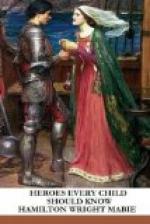“About eighty of the lepers were in the hospital; the others, with a very few Kokuas (helpers), had taken their abode farther up toward the valley. They had cut down the old pandanus groves to build their houses, though a great many had nothing but branches of castor-oil trees with which to construct their small shelters. These frail frames were covered with ki leaves or with sugar-cane leaves, the best ones with pili grass. I, myself, was sheltered during several weeks under the single pandanus-tree which is preserved up to the present in the churchyard. Under such primitive roofs were living without distinction of age or sex, old or new cases, all more or less strangers one to another, those unfortunate outcasts of society. They passed their time with playing cards, hula (native dances), drinking fermented ki-root beer, home-made alcohol, and with the sequels of all this. Their clothes were far from being clean and decent, on account of the scarcity of water, which had to be brought at that time from a great distance. Many a time in fulfilling my priestly duty at their domiciles I have been compelled to run outside to breathe fresh air. To counteract the bad smell I made myself accustomed to the use of tobacco, whereupon the smell of the pipe preserved me somewhat from carrying in my clothes the noxious odour of the lepers. At that time the progress of the disease was fearful, and the rate of mortality very high. The miserable condition of the settlement gave it the name of a living graveyard, which name, I am happy to state, is to-day no longer applicable to our place.”
In 1874 a “cona” (south) wind blew down most of the lepers’ wretched, rotten abodes, and the poor sufferers lay shivering in the wind and rain, with clothes and blankets wet through. In a few days the grass beneath their sleeping-mats began to emit a “very unpleasant vapour.” “I at once,” says Father Damien, “called the attention of our sympathising agent to the fact, and very soon there arrived several schooner-loads of scantling to build solid frames with, and all lepers in distress received, on application, the necessary material for the erection of decent houses.” Friends sent them rough boards and shingles and flooring. Some of the lepers had a little money, and hired carpenters. For those without means the priest, with his leper boys, did the work of erecting a good many small houses.
“I remember well that when I arrived here,” again says Father Damien, “the poor people were without any medicines, with the exception of a few physics and their own native remedies. It was a common sight to see people going round with fearful ulcers, which, for the want of a few rags or a piece of lint and a little salve, were left exposed. Not only were their sores neglected but any one getting a fever, or any of the numerous ailments that lepers are heir to, was carried off for want of some simple medicine.




